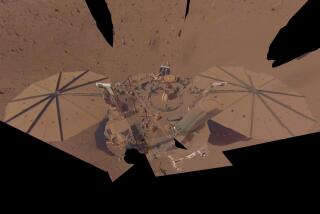Puffy clouds, blue water: NASA video depicts Mars 4 billion years ago
- Share via
Don’t be fooled – this epic video of plump clouds, clear lakes and gorgeous landscapes isn’t from some remote vacation spot on Earth. This could be what Mars looked like about 4 billion years ago, NASA scientists say.
The video (which you can watch above) also shows how Mars may have transitioned from a lush paradise into the desert-like Red Planet we know today.
Scientists working on the Mars Atmosphere and Volatile Evolution mission, known as MAVEN, which is scheduled to launch Monday, are hoping to figure out whether the planet really could have looked like that – and if so, for how long.
It may seem hard to believe, given that the green-blue scenery in the video is such a far cry from the dry, dusty, rusty-looking ball of cold rock that exists today. But other Mars orbiters and rovers have picked up ample signs in previous years that water once flowed across the Martian surface.
“I wouldn’t be surprised if, for many tens of millions of years, Mars was a pretty friendly place with natural water, wind, waves and rain,” said Paul Mahaffy, who works at NASA’s Goddard Space Flight Center in Greenbelt, Md., and is in charge of instruments on both MAVEN and NASA’s Mars rover Curiosity. “But I think we just don’t know.”
Scientists have identified craters that they think were once filled with lakes and layered rock in the shape of river deltas. Curiosity, which is searching for life-friendly environments on Mars, sampled clay minerals in Gale Crater this year that scientists say clearly showed chemical alteration from exposure to water.
Liquid water can’t exist on the Martian surface today – it would quickly freeze or boil off, because the low-pressure atmosphere is far too cold and thin to keep it in. (A thicker atmosphere keeps in more heat – that’s why it’s much colder at the top of a mountain on Earth, where the air is thinner.)
If there had been water on the surface of Mars in ancient times, then the atmosphere must have been much thicker and warm enough to hold liquid water, scientists say. If so, there could have been clouds and a complex water cycle – and perhaps even an opportunity for life to exist.
But for some reason, Mars lost much of that protective atmosphere. Scientists on the MAVEN mission want to find out when and how it vanished.
There are many theories. For example, asteroids and comets could have bombarded the surface so heavily that they blew out much of the gas. In addition, Mars may have lost its protective magnetic field that would have shielded it from erosion from the sun’s rays.
The researchers want to know whether the thick atmosphere lasted for a very long time or was a relative blip in Martian history. If the sun was responsible for burning off much of the atmosphere – which is the leading theory at the moment – did it happen gradually or very suddenly?
By using its suite of instruments to study the sun’s present-day effects on the uppermost layers of the atmosphere, the MAVEN team hopes to extrapolate what the Martian atmosphere looked like billions of years ago – and if it really was as lush as the video above envisions.
The video was produced at Goddard Space Flight Center.
ALSO:
Did snow fall on Mars? Melt water may have carved slopes: study
Mars’ once-thick atmosphere now stripped; bad news for life?
Cirrus-ly? MIT scientists make icy Martian clouds on Earth
NASA’s glamor shot of Saturn includes Earth, moon as tiny specks







